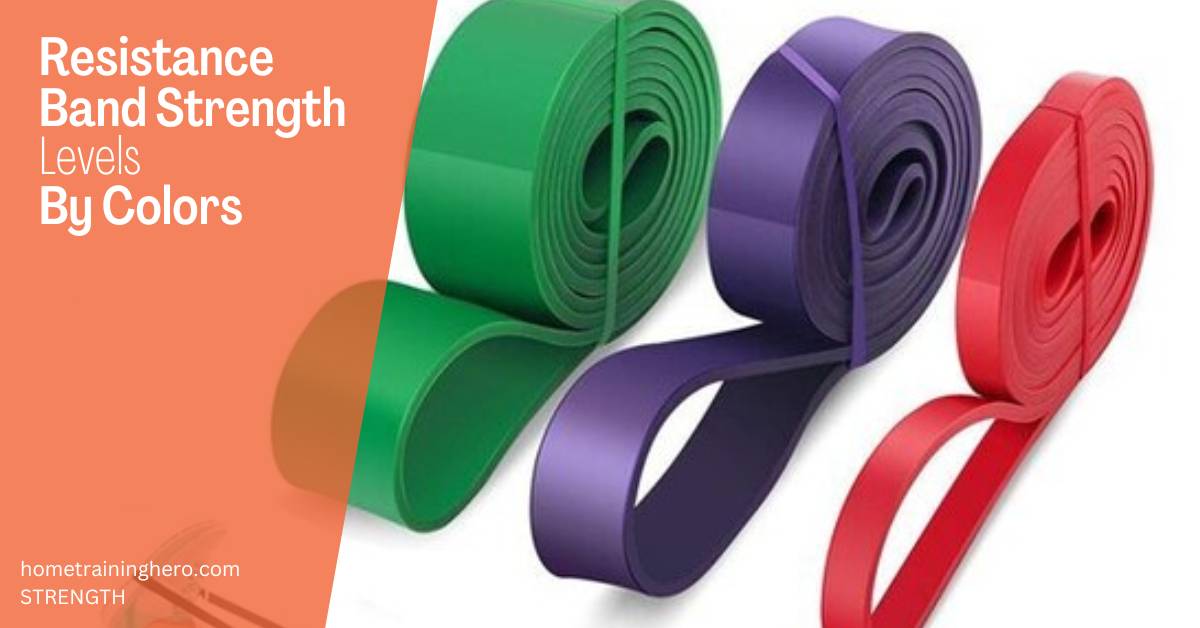Resistance bands are versatile and effective tools for strength training, rehabilitation, and overall fitness. They come in various colors, which are often associated with specific resistance levels.
In this article, we will explore the different resistance bands strength levels by color – and how you can incorporate them into your workout routine.
Let’s jump straight to it!
Contents
Resistance Bands Strength by Color: The Color-Coded System
The color-coded system is widely used to categorize resistance bands based on their strength levels. While the exact colors and corresponding strengths may vary between manufacturers, there is a general consensus among fitness experts on the following color scheme:
- Yellow (Light): The yellow resistance band offers the lightest level of resistance. It is ideal for beginners, those recovering from injuries, or individuals looking to perform exercises with less intensity.
- Green (Medium): The green resistance band provides a moderate level of resistance. It is suitable for individuals who have developed some strength and flexibility and want to further challenge themselves.
- Red (Heavy): The red resistance band is considered heavy and provides a higher level of resistance. It targets muscles effectively and is commonly used by intermediate to advanced fitness enthusiasts.
- Blue (Extra Heavy): The blue resistance band is extra heavy and offers a significant amount of resistance. It is recommended for experienced lifters or individuals looking for an intense workout.
- Black (Ultra Heavy): The black resistance band is the highest level of resistance available. It is designed for professional athletes and individuals who are highly trained and require maximum resistance.
| Color | Strength Level | Recommended Users |
|---|---|---|
| Yellow | Light | Beginners, Injury Recovery, Low Intensity Exercises |
| Green | Medium | Those with Some Strength and Flexibility |
| Red | Heavy | Intermediate to Advanced Fitness Enthusiasts |
| Blue | Extra Heavy | Experienced Lifters, Intense Workouts |
| Black | Ultra Heavy | Professional Athletes, Highly Trained Individuals |
Choosing the Right Resistance Level
Selecting the appropriate resistance level is crucial for maximizing the effectiveness of your workout and minimizing the risk of injury. It is essential to understand your fitness goals, current strength levels, and the exercises you plan to perform.
If you are a beginner or recovering from an injury, starting with a lighter resistance band such as yellow or green is advisable. This allows you to focus on proper form and gradually build strength. As you progress and feel more comfortable, you can gradually move to higher resistance levels.
Intermediate to advanced fitness enthusiasts can experiment with different resistance levels based on their specific needs. A combination of bands with varying strengths can be used to target different muscle groups and prevent plateauing in your training.
Additionally, it is important to consider the type of exercise you are performing. For example, a lighter band might be suitable for upper-body exercises, while a heavier band may be required for lower-body workouts.
Benefits of Resistance Bands
Resistance bands offer numerous benefits that make them a popular choice among fitness enthusiasts:
- Portability: Resistance bands are lightweight and compact, making them easy to carry and use anywhere, whether at home, the gym, or even while traveling.
- Versatility: With resistance bands, you can perform a wide variety of exercises targeting different muscle groups, including arms, legs, chest, back, and core.
- Joint-Friendly: Unlike free weights or machines, resistance bands provide constant tension throughout the exercise, reducing stress on the joints and minimizing the risk of injuries.
- Progressive Resistance: Resistance bands allow for progressive resistance, meaning you can increase the challenge as you gain strength and endurance by using bands with higher resistance levels.
- Cost-Effective: Compared to traditional fitness equipment, resistance bands are affordable and offer a cost-effective way to achieve your fitness goals.
Incorporating Resistance Bands into Your Workout
Now that you understand the strength levels of resistance bands and their benefits, let’s explore some ways to incorporate them into your workout routine:
- Upper Body Exercises: Use resistance bands for exercises like bicep curls, tricep extensions, shoulder presses, and chest presses to strengthen and tone your upper body muscles.
- Lower Body Exercises: Perform squats, lunges, hip thrusts, and glute bridges with resistance bands to target your leg and glute muscles effectively.
- Pilates and Yoga: Enhance your Pilates and yoga sessions by incorporating resistance bands to add extra resistance and engagement to your movements.
- Stretching and Mobility Exercises: Resistance bands can also be used for stretching and improving flexibility. They can assist in deepening stretches or providing resistance during mobility exercises.
Remember to start with proper warm-up exercises before using resistance bands and to cool down and stretch afterward to prevent muscle soreness and promote recovery.
Final Words
Understanding the strength levels of resistance bands by color allows you to choose the most appropriate band for your fitness goals and abilities.
By incorporating resistance bands into your workout routine, you can enhance your strength, flexibility, and overall fitness levels. Remember to gradually progress to higher resistance levels as you become stronger and more confident.
Enjoy the versatility and convenience that resistance bands offer, and take your fitness journey to new heights!
Other Helpful Resources
- Comparing TRX vs Resistance Bands: Which is Better for Your Workout?
- Discover the Top 10 Best Brand Resistance Bands for Effective Workouts
- Can Resistance Bands Replace Weights: A Comprehensive Guide
- What Type of Resistance Bands Should I Buy? The Ultimate Guide to Choosing the Right Resistance Bands
- Are Resistance Bands Good for Building Muscle? Science And Facts




